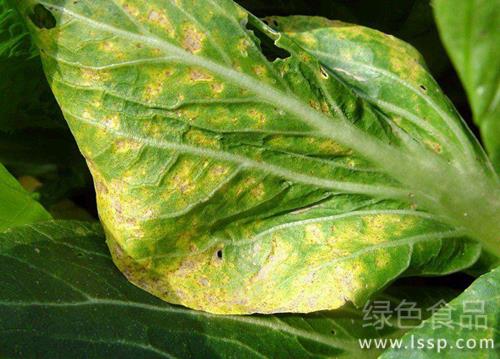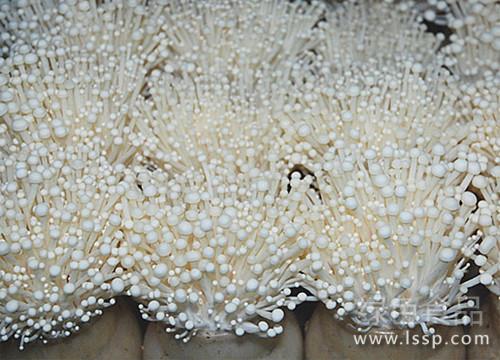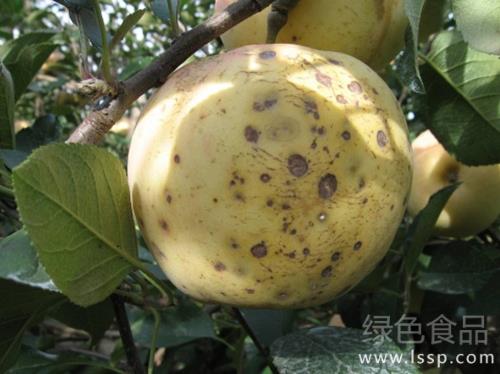Prevention and treatment of virus disease of Brassica campestris var. chinensis twisted leaves
Chinese cabbage virus disease, also known as Guding disease, seriously threatens cabbage production. After the occurrence of virus disease, Chinese cabbage is most likely to be complicated with downy mildew and soft rot because of its low disease resistance.

Chinese cabbage virus disease
1. Symptoms:
In the early stage of seedling disease, bright veins appeared in the heart leaves, faded along the veins, and gradually turned into light green and thick green flowers and leaves. The diseased leaves were wrinkled and crisp, and the heart leaves were twisted and deformed. Some cabbages produce brown necrotic spots or stripes on the main veins on the back of the leaves, and the petiole curls to one side. The disease occurred in the adult stage, the leaves also showed seedling symptoms, the serious disease of Chinese cabbage dwarfed, unwrapped, stopped growing, the root system was underdeveloped, the whisker root was less, and the root was cut open, which could be seen that the section turned brown. For susceptible Chinese cabbage, the bolting is late, short and curved, the leaves are small and hard, the new leaves are bright, or the old leaves fade along the veins, the main veins of the old leaves are necrotic, there are longitudinal and transverse cracks on the pedicels, the pods are thin and curved, the seeds are not full, the seed germination rate is low, and the susceptible plants die before the bolts are taken out.
two。 Pathogen and incidence regularity
(1) pathogen. Chinese cabbage virus disease is caused by single or mixed infection of several viruses, such as Daphne mosaic virus, cucumber mosaic virus, tobacco mosaic virus, radish mosaic virus and so on. (2) infection cycle. The virus mainly overwinters on infected cabbage plants or cellars at the end of autumn, and the following year, aphids or other viral vectors upload the virus from overwintering Chinese cabbage to spring-sown Chinese cabbage, and then spread from these vegetables to autumn-sown Chinese cabbage. (3) the condition of onset. Chinese cabbage seedling to rosette stage, such as less rainfall, high temperature and drought, serious disease. In addition, extensive management, insufficient base fertilizer, too little watering, too late seedlings, poor growth and so on can make the disease occur and epidemic.
3. Prevention and cure method
(1) selecting disease-resistant varieties. Qingbang cabbage is more disease-resistant than Baibang, and late-maturing is more disease-resistant than early-maturing.
(2) selection and retention of disease-free plants. Leave seeds and select disease-free plants in disease-free fields, and select disease-free plants when planting all kinds of plants.
(3) timely and late broadcast. Sowing seeds in the first 3 days or 5 days after the Beginning of Autumn can be sowed early in rainy years, while in dry years, cabbage varieties with short growth period can be sowed late.
(4) strengthen field management. Deep ploughing and careful cultivation, adequate application of mature farm manure, increased application of phosphorus and potassium fertilizer, eradication of weeds in the field and surrounding areas, cleaning the countryside, and reducing the primary infection source and transmission vector of the virus. Combined with seedlings, pull out weak seedlings, diseased seedlings, reasonable watering, high temperature and drought, can increase the watering times, in order to reduce ground temperature and prevent virus diseases.
(5) prevention and control of aphids and virus vectors. Can be sprayed 3000 times with 50% aldicarb wettable powder. 10% imidacloprid wettable powder 1000-2000 times liquid spray.
(6) Pesticide control. At the initial stage of the onset of Chinese cabbage virus disease, you can use 20% virus A wettable powder 500x, or 1.5% Zhishiling emulsion 1000 times, or 83 enhancer 100x spray, spray once every 7-10 days, 2-3 times in a row.
- Prev

Cultivation techniques of Flammulina velutipes with poor quality after three crops in conventional cultivation
Cultivation techniques of Flammulina velutipes with poor quality after three crops in conventional cultivation
- Next

Bitter pox wrinkle water heart disease is due to calcium deficiency how to prevent and treat apple calcium deficiency
Bitter pox wrinkle water heart disease is due to calcium deficiency how to prevent and treat apple calcium deficiency
Related
- Fuxing push coffee new agricultural production and marketing class: lack of small-scale processing plants
- Jujube rice field leisure farm deep ploughing Yilan for five years to create a space for organic food and play
- Nongyu Farm-A trial of organic papaya for brave women with advanced technology
- Four points for attention in the prevention and control of diseases and insect pests of edible fungi
- How to add nutrient solution to Edible Fungi
- Is there any good way to control edible fungus mites?
- Open Inoculation Technology of Edible Fungi
- Is there any clever way to use fertilizer for edible fungus in winter?
- What agents are used to kill the pathogens of edible fungi in the mushroom shed?
- Rapid drying of Edible Fungi

